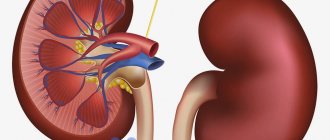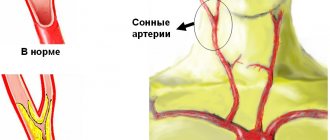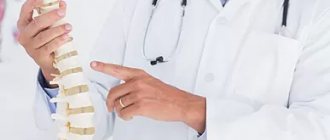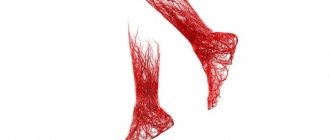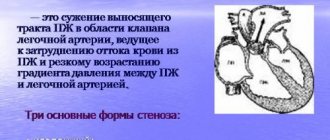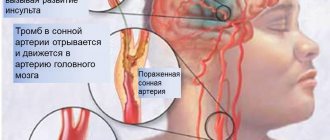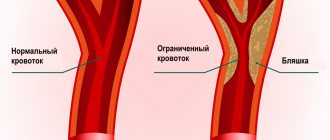Aching, headache... How often do we have to talk about this. And sometimes a person does not attach importance to the onset of a migraine, attributing his poor health to a sharp change in temperature, pressure changes, age, or simply to his own fatigue or lack of sleep. Most people take headaches for granted and do not consider it a problem. But, in fact, such a harmless symptom may hide processes that are dangerous to the body. For example, discirculatory encephalopathy. Simply put, it is a narrowing of blood vessels in the brain. Due to the narrowing, blood does not flow to the brain in sufficient quantities. And if a large area of the brain is damaged by this process, a “harmless” headache or dizziness can lead to ischemia.
Causes
What causes the narrowing of the vascular lumen? Often the culprit is a chronic disease, accompanied by the accumulation of cholesterol molecules on the walls of the arteries - atherosclerosis. Atheromatous deposits harden and narrow the vascular lumen, preventing normal blood circulation. Over time, the amount of cholesterol deposits increases, which can lead to stenosis or occlusion of the vessel. In addition, the walls of the artery affected by atherosclerosis weaken and lose their elasticity - this leads to the development of aneurysms. Such a neoplasm impedes blood flow and poses a threat of rupture, which we wrote about in more detail earlier.
The development of atherosclerosis is facilitated by factors that are related to the environment, lifestyle and human heredity. The formation of plaques in blood vessels is provoked by smoking (the blood vessels are narrowed and blood flow to the heart muscle is reduced), obesity, and lack of physical activity. Find out about these and other causes of atherosclerosis here.
Causes of deterioration of blood circulation in the brain
In some pathologies, stenosis (narrowing) of the lumen of the vessel or its obstruction (blockage) occurs. As a result, the speed of blood flow slows down, ischemia (oxygen starvation of the tissue) occurs in certain areas of the brain, leading to necrosis (death) of the tissue.
Risk factors are:
- hypertension;
- cardiac ischemia;
- diabetes;
- hormonal imbalance, including the use of contraceptives;
- atherosclerosis;
- overweight;
- physical inactivity;
- stress;
- alcohol abuse, smoking;
- lipid metabolism disorder.
Complications
Narrowed blood vessels cause disability and death every year.
- In first place among the causes of mortality is coronary heart disease, which is accompanied by necrotic damage to the heart muscle - myocardial infarction caused by circulatory disorders.
- Ischemic cerebral infarction is no less dangerous due to its consequences. It develops as a result of atherosclerotic damage to the arteries supplying blood to the brain. Headaches, short-term blindness, speech impairment and other symptoms of transient ischemic attack become consequences of carotid artery stenosis. An occlusion that suddenly occurs in any part of the carotid or vertebral arteries leads to ischemia and necrosis of areas of brain tissue.
- Vascular diseases of the lower extremities associated with narrowing of the arteries have a negative impact on a person’s quality of life. A disease such as atherosclerosis of the blood vessels of the legs, in its advanced form, leads to gangrene and loss of a limb.
Get ahead of the disease and help yourself
The prognosis for a disease such as cerebral vasoconstriction depends mainly on how quickly it was diagnosed and how quickly treatment was started. The technique should only be determined by the attending physician. Because in each specific case, tactics must be individual. However, the following can serve as general recommendations:
- It is necessary to change the food system, where the daily diet must certainly consist of fresh vegetables and fruits containing useful substances and always greens! Be sure to include fish in your daily menu, but it is better to limit sweets, smoked foods, sausage, carbonated water, and salt or eliminate them altogether.
- You should reconsider your lifestyle and engage in more sports, go for walks in nature more often, get fresh air, start an active, eventful life, prevent excess weight, and move a lot.
How to detect vasoconstriction?
It is imperative to consult a doctor and undergo a vascular examination if you experience unpleasant symptoms of vascular diseases. These include:
- Sudden dizziness and short-term loss of vision, sometimes accompanied by numbness of one half of the body.
- An alarming sign is angina pectoris. This is a syndrome in which the patient feels paroxysmal pain in the heart area during physical activity or stress.
- You should see a doctor if you begin to notice pain in your legs and lameness when walking, coldness and paleness of your limbs.
The suspicion that narrowed vessels pose a clear threat to life gives grounds for examination of the arteries. In this case, in addition to examination by a doctor, the following are additionally prescribed:
- Blood chemistry. High cholesterol levels in the blood are a symptom of atherosclerosis.
- Vascular magnetic resonance imaging (MRI). This method will show changes in the structure of blood vessels.
- Angiography. This research method will show the exact location of atherosclerotic plaques and how severely the vessels are narrowed.
- Dopplerography. It helps to see the artery, assess its condition and blood flow.
Signs of cerebral vasoconstriction
There can be many reasons for the narrowing of blood vessels in the brain. But, you should pay attention specifically to the forms of the already established disease: initial and chronic. It is difficult to judge which of them is most dangerous for the human body. Because the chronic form can plague a person for years, and the initial form can lead to death at the very first stage.
That is why it is so important not to miss the first “bells” of the onset of the disease.
So, the following signs should alert you:
- functional disorders of the central nervous system (fatigue, migraines, unexplained irritability, tearfulness, overexcitation, touchiness);
- incipient memory problems (short-term forgetfulness, inability to remember what happened a few minutes ago - the name of the program, the location of the keys, etc.);
- change in gait (a person shuffles his feet or minces heavily);
- the appearance of a false urge to urinate;
- loss of coordination of movements, loss of balance;
- development of dementia;
- malfunctions in the functioning of internal organs located in the pelvic area.
Coronary artery stenosis - symptoms and treatment
There are two groups of treatment methods:
- conservative and medicinal;
- surgical.
In the early stages of the disease, conservative treatment . It involves changing your lifestyle towards a healthy one, giving up bad habits, optimizing your level of physical activity and following a low-cholesterol diet. Meals should be fractional. The consumption of salt, sweets, alcohol, fatty meats and baked goods is limited. The diet includes vegetable oils, fish oil and complex carbohydrates found in cereals. It is also important to drink up to 2 liters of liquid and change the principle of cooking: foods should be boiled, stewed or baked.
For coronary heart disease, medications are prescribed , for example:
- hypocholesterol drugs - reduce blood cholesterol levels (statins, fibrates, PCSK9 inhibitors, ezetimibe);
- disaggregants and anticoagulants - “thin” the blood, reduce its coagulability and viscosity, prevent the formation of blood clots (acetylsalicylic acid, clopidogrel, warfarin, apixaban, rivaroxaban, dabigatran, prasugrel);
- antianginal - dilate blood vessels, prevent attacks of angina (nitroglycerin, amlodipine, sidnopharm, bisoprolol, ranolazine);
- angioprotectors - protect blood vessels from damage and stretching (ACE inhibitors);
- medications to stabilize blood pressure, reduce heart rate and prevent arrhythmias - diuretics (indapamide, hypothiazide, torsemide), ACE inhibitors (ramipril, perindopril), beta-blockers (metoprolol, bisoprolol) and ivabradine;
- metabolic - normalize metabolism (trimetazidine, neoton).
The duration of use for each drug is different. Dose adjustments and replacement of medications are carried out strictly under the supervision of a physician.
Surgical treatment includes two main types of treatment for coronary artery stenosis:
- stenting;
- shunting.
Stenting involves installing a stent into a narrowed vessel. The stent is a metal frame. Using a guide through the femoral or radial artery, this frame is advanced to the affected coronary artery, fixed there and straightened. It prevents the artery from narrowing and normalizes blood flow.
Stenting is performed both planned for the prevention of myocardial infarction and urgently. The operation is minimally invasive: it does not require extensive incisions or general anesthesia.
Bypass surgery aims to create a new blood flow path around the blocked vessel. The material for the shunt is the patient's own veins and arteries. The surgeon stitches them above and below the narrowing of the coronary artery.
Such manipulation involves opening the chest, often leading to long rehabilitation and serious complications, such as ischemic stroke, anemia, arrhythmia, blockage of shunts with a blood clot, prolonged healing of the sternum with the formation of a false joint and the formation of fluid in the lungs, swelling and long healing of the leg [1] [2][3][4][5][6][7][8][9][10][13][14][15][16][17][18][19][20 ][21].
There is also a third surgical method for treating stenosis - endarterectomy . It involves removing a blood clot and cholesterol plaque from the lumen of the heart artery. However, now endarterectomy is practically not used, since it is accompanied by high risks and does not exclude the re-formation of blood clots.
Consequences of cerebral circulatory disorders
The brain is the organ most vulnerable to lack of oxygen. The circulating blood volume in the brain remains virtually unchanged and is about 750 ml. Since nervous tissue is not able to retain oxygen, its reserve lasts for 8–10 seconds. When brain cells are deprived of blood supply, that is, there is no access to vital nutrients and oxygen, they die - a stroke occurs.
The consequences of a stroke can vary widely depending on the area of the brain, the severity of the impairment, and the general health of the person.
Cerebral circulatory disorders include:
- cerebral hemorrhage,
- thrombosis,
- embolism (blockage),
- subarachnoid hemorrhage.
They are usually the result of pre-existing vascular disease, congenital pathology, or may be triggered by trauma.
Symptoms of poor blood circulation in the brain
There are acute (CVA - stroke) and chronic (CDC - dyscirculatory encephalopathy) cerebrovascular accident (CVA).
The following symptoms are characteristic of OMNC:
- sudden weakness, stupor;
- short-term loss of consciousness;
- numbness of the face, arms, legs;
- headache;
- dizziness;
- dry mouth;
- sweating;
- nausea, vomiting;
- disorientation;
- deterioration of speech.
With CNMK the following symptoms develop:
- memory impairment;
- changes in the emotional sphere;
- headache;
- dizziness;
- movement disorders, including changes in gait, frequent falls;
- decrease in intellectual activity, social adaptation;
- speech defects;
- dementia (dementia).
Symptoms
Symptoms of vasoconstriction in the cervical spine do not appear for a very long time, and a person with this disease does not notice any deterioration in well-being. However, later in the development of the disease it begins to manifest itself:
- constant dizziness;
- lack of strength even with constant rest;
- sudden loss of consciousness for no reason;
- flickering before the eyes;
- noise or ringing in the ears;
- pressing or aching pain in the head, particularly in the back of the head, may spread to the neck.
In general, two groups of symptoms can be distinguished. The first group includes manifestations that reduce a person’s level of performance, but do not lead to a desire to visit a doctor. The second group includes obvious pain manifestations and symptoms that indicate significant blockage of blood vessels and the need for urgent hospitalization of the person.
